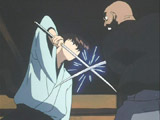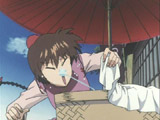

Quick Links:
Carried by the Wind: Tsukikage Ran, Volume 1: A Tale of Two Travellers
Fans of the underrated Jubei-Chan series have the right to rejoice, as Bandai has brought another of Akitaro Daichi's wonderful tales to America with many interesting twists and excellent extras that would please any otaku. The story, which puts a spin on an age-old formula, screams Daichi, as its execution, style, and charm all come together to make one extremely worthwhile experience that will quench any drama, comedy, or samurai fan's thirst for something different, but not too different.
The story focuses around two characters: Ran, a mysterious, soft-spoken female samurai, and Lady Meow, a somewhat hyperactive master (mistress?) of the Cat Fist school of martial arts. They.. aren't exactly a team, but Meow seems to think so and tags along with Ran whenever she can. Unfortunately, Ran isn't so big on the thought at first, and sees Lady Meow as more of an annoyance. Uneventful as it may seem, the two travel from town to town in search of one thing, well... two things for Ran. The two both share the mutual goal of defending justice and what try to right the wrongs they come across in every town they pass through. Ran's secondary goal, however, is simple: to find good sake and lots of it. However, the two often seem to go hand-in-hand, as the cost of sake always seems to have a price.
Ran's story, while seemingly simple, is often made more complicated than it seems. Everywhere the two travelers go, several different (and sometimes unusual) situations tend to arise for both of them. Of course, the two always see it fit for them to involve themselves and try to help these poor villagers, and hopefully get some personal gain in the end. Of course, it is an old formula, but the range of situations that the two travelers encounter are more than enough to make things seem fresh once again.
Excellent character designs definitely complement a decent story to make it truly endearing. Take Ran, for example: She is a very simple samurai-type character that is dressed in the traditional samurai attire that consists of a sword, a hakamia, and haori. However, there are many fine details in her character, such as the ribbon that ties her hair back to the designs on the handle of her katana, to even her decorative sake flask. Despite her stern appearance, Ran actually shows a great range of expressions, ranging from happy to the always-funny shocked expression. Lady Meow (or Meow for short) is much more outgoing, with a cute (but not too cute design) that shows her exponentially sunnier disposition compared to Ran. To further accentuate this visual comparison, Meow is decked in a more foreign attire that looks more like it hails from China rather than Japan. Meow's costume allows for some delectable details that the animators decided to include, such as the cloth wrap around her stomach, and the tiny knot keeping her braid in place. Of course, with good primary characters, worthy secondary characters are a must. Fortunately, for the most part, such an expectation comes true. There are several interesting characters, such as the elderly sake master, the Benitsubake bodyguard, and Mametaro the baby. Unfortunately, among the stellar secondary characters, there are also a few very generic characters that seem out of place. Other than the few generic characters, Tsukikage Ran looks to have a very balanced and fun cast to this point.
To accentuate great characters, good animation is a definite requisite. Fortunately, the folks at Sunrise seem to realize this, and graced Ran with very fluid, lifelike animation to complement the realistic characters and setting. As a very nice touch, in many of the town scenes, several of the characters in the background also move and interact, allowing for a more immersive and enjoyable experience. However, the best examples of the stellar animation would have to be the fight scenes, which are beautifully choreographed and masterfully performed. There is absolutely no breakup in the animation as each of the exciting (albeit short) battles rages on. Actually, the few times the animation did reuse frames or become choppy was to highlight comedic moments. Although it is slightly annoying, it is not common enough to take the score down too much.
Unfortunately, the shortest point of Ran has to be its music. It is not that it is not well-done. The fact is, it just isn't memorable. All of the songs, ,which are performed with a mix of instruments both modern and traditional, are used to create a variety of melodies that all have a more traditional "classical Japanese" sound. Of course, there are a few exceptions, such as one piece that seems it would fit a '70s action movie, or an '80s porn flick. Fortunately, other than the one or two mediocre songs, the rest of the music is very fitting to the series, especially the opening, which takes a page from several older Japanese films.
Of course, being a DVD, several other factors have to be considered as well. The video, for example, is simply wonderful since it came from a recent master. The colors are rich and vibrant, with no bleeding or cross-coloration. Aliasing, aka "jaggies" are also virtually non-existant, which is a wonderful blessing for viewers. Another pleasing fact is that there is absolutely no macroblocking in the disc whatsoever. Bandai definitely did its homework when it treated the video for Tsukikage Ran, as it is almost flawless in its execution.
Moving to audio, this disc was watched three times: Once in its native Japanese, once in English, and once with subtitles and switching between the two in five minute intervals. From repeated viewings, this disc shows very good sound quality in all aspects. No audible dropouts or distortions could be heard in either of the tracks, which gives a feeling of quality throughout. Also, the fact that there is absolutely no static on the disc is very nice, since even the smallest crackle can detract from show's overall enjoyment.
Of course, what is a DVD without a fun selection of extras to give to the viewers? Bandai has created an otaku's dream with a very detailed colection of liner notes that put even a few fansubs to shame. Also included is the interesting commercial collection that showcases four television commercials that aired on Japanese television. Another nice little bonus is the art gallery, which showcases seven production sketches of the characters that appear on the disc. Finally, the extras menu closes with its normal assortment of trailers and production credits. Unfortunately, there is no textless opening, but one can only assume that it will show up on a later volume, or show up as an easter egg. Fortunately, with such a strong set of extras, it is easy to overlook the absence of one minor item.
Actually, there are very few faults with this series at all, and is well worth watching, especially if it's to satisfy the inner Kenshin or Jubei-chan fan. All of the elements (yes, even the less stellar ones) come together to form a great show that is well worth anybody's time.
Distributor: Bandai Entertainment Creator: Bandai Visual/ ZRO Limit Productions/ Animaze Released: 2000
Video Quality: A- Audio Quality: B+ Presentation: A Content: B- Overall: B+



